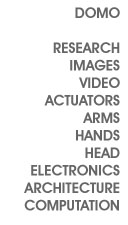Manipulation in Human
Environments
Robots that work alongside
us in our homes and workplaces could extend the time an elderly person can
live at
home, provide physical assistance to a worker on an assembly line, or help
with household chores. In order to assist us in
these ways, robots will need to successfully perform manipulation tasks within
human environments. Human environments present
special challenges for robot manipulation since they are complex, dynamic,
uncontrolled, and difficult to perceive reliably.
In this paper we present a behavior-based control system that enables a humanoid
robot, Domo, to help a person place objects
on a shelf. Domo is able to physically locate the shelf, socially cue a person
to hand it an object, grasp the object that has been
handed to it, transfer the object to the hand that is closest to the shelf,
and place the object on the shelf. We use this behavior-based control system
to illustrate three themes that characterize our approach to manipulation
in human environments. The first theme, cooperative manipulation, refers to
the advantages that can be gained by having the robot work with a person to
cooperatively perform manipulation tasks. The second theme, task relevant
features, emphasizes the benefits of carefully selecting the aspects of the
world that are to be perceived and acted upon during a manipulation task.
The third theme, let the body do the thinking, encompasses several ways in
which a robot can use its body to simplify manipulation tasks.
Edsinger, Aaron and
Kemp, Charles C. "Manipulation in Human Environments". Proceedings of the IEEE/RSJ International Conference on Humanoid Robotics, 2006.[PDF]
Toward Robot Learning
of Tool Manipulation from Human Demonstration
Robots that manipulate
everyday tools in unstructured, human settings could more easily work with
people and perform tasks that are
important to people. Task demonstration could serve as an intuitive way for
people to program robots to perform tasks. By focusing on
task-relevant features during both the demonstration and the execution of
a task, a robot could more robustly emulate the important
characteristics of the task and generalize what it has learned. In this paper
we describe a method for robot task learning that makes use
of the perception and control of the tip of a tool. For this approach, the
robot monitors the tool's tip during human use, extracts the
trajectory of this task relevant feature, and then manipulates the tool by
controlling this feature. We present preliminary results
where a humanoid robot learns to clean a flexible hose with a brush. This
task is accomplished in an unstructured environment
without prior models of the objects or task
Edsinger, Aaron and
Kemp, Charles C. "Toward Robot Learning of Tool Manipulation from Human
Demonstration". Unpublished 2006.[PDF]
The Development of
Visual Categories for a Robot's Body and the World that it Influences
We present a developmental
perceptual system for a humanoid robot that autonomously discovers its hand
from less than 2 minutes of natural interaction with a human. The perceptual
system combines simple proprioceptive sensing with a visual attention system
that uses motion to select salient regions. We show that during natural interactions
with a person, the majority of the selected visual regions consist of significant
body parts on the human and robot (hands, fingers, and the human's head).
The system visually clusters the selected image regions, models their spatial
distribution over a sensory sphere, and uses mutual information to determine
how much the clusters are influenced by the robot's arm. In our tests, the
visual cluster that most strongly relates to the robot's arm primarily contains
images of the robot's hand, and has a spatial distribution that can predict
the location of the robot's hand in the image as a function of the arm's configuration.
Kemp, Charles C. and
Edsinger, Aaron. "What Can I Control?: The Development of Visual Categories
for a Robot's Body and the World that it Influences". Proceedings of
the Fifth International Conference on Development and Learning, Special Session
on Autonomous Mental Development. 2006.[PDF]
Autonomous Detection
and Control of Task Relevant Features
The efficient acquisition
and generalization of skills for manual tasks requires that a robot be able
to perceive and control the
important aspects of an object while ignoring irrelevant factors. For many
tasks involving everyday tool-like objects, detection and control of the distal
end of the object is sufficient for its use. For example, a robot could pour
a substance from a bottle by controlling
the position and orientation of the mouth. Likewise, the canonical tasks associated
with a screwdriver, hammer, or pen rely on control
of the tool's tip. In this paper, we present methods that allow a robot to
autonomously detect and control the tip of a tool-like
object. We also show results for modeling the appearance of this important
type of task relevant feature.
Kemp, Charles C. and
Edsinger, Aaron. "Robot Manipulation of Human Tools: Autonomous Detection
and Control of Task Relevant Features". Proceedings of the Fifth International
Conference on Development and Learning, Special Session on Classifying Activities
in Manual Tasks. 2006.[PDF]
Visual Tool Tip Detection
and Position Estimation
Robots that use human
tools could more easily work with people, per form tasks that are important
to people, and benefit from human strategies for accomplishing these tasks.
For a wide variety of tools and tasks, control of the tool's endpoint is sufficient
for its use. In this paper we present a straight-forward method for rapidly
detecting the endpoint of an unmodeled tool and estimating its position with
respect to the robot's hand. The robot rotates the tool while using optical
flow to detect the most rapidly moving image points, and then finds the 3D
position with respect to its hand that best explains these noisy 2D detections.
The resulting 3D position estimate allows the robot to control the position
of the tool endpoint and predict its visual location. We show successful results
for this method using a humanoid robot with a variety of traditional tools,
including a pen, a hammer, and pliers, as well as more general tools such
as a bottle and the robot's own finger.
Kemp, Charles C. and
Edsinger, Aaron. "Visual Tool Tip Detection and Position Estimation for
Robotic Manipulation of Unknown Human Tools", Massachusetts Institute
of Technology, CSAIL, Tech. Report AIM-2005-037 [PDF]
Ego-Exo Discrimination
Ego-exo discrimination
can be seen as a basic underpinning in the formulation of a notion of the
``ecological self''. The ecological self is a physically embodied representation
of the self, derived from the direct relationships between the body and its
environment. The representation is constructed through explorations and interactions
in the world. It is our position that on a robot, an ecological self should
be be constructed over time, according to a developmental plan. Early, simple
exploratory behaviors can generate the sensorimotor experiences necessary
to scaffold further stages in the construction. One step in such a developmental
approach for a humanoid robot is to incorporate, at the lowest level, the
notion of ego-exo discrimination.
Edsinger-Gonzales, Aaron.
"Developmentally Guided Ego-Exo Force Discrimination for a Humanoid Robot
", In submission: Fifth International Workshop on Epigenetic Robotics.
Nara, Japan, 2005. [PDF]
Domo Design.
Humanoid robots found
in research and commercial use today typically lack the ability to operate
in unstructured and unknown environments. Force sensing and compliance at
each robot joint can allow the robot to safely act in these environments.
However, these features can be difficult to incorporate into robot designs.
We present a new force sensing and compliant humanoid under development in
the Humanoid Robotics Group at MIT CSAIL. The robot, named, Domo, is to be
a research platform for exploring issues in general dexterous manipulation,
visual perception, and learning. In this paper we describe aspects of the
design, detail proposed research directions for the robot, and illustrate
how the design of humanoid robots can be informed by the desired research
goals.
Edsinger-Gonzales, Aaron
and Jeff Weber. "Domo: A Force Sensing Humanoid Robot for Manipulation
Research", Proceedings of the IEEE/RSJ International Conference on Humanoid
Robotics, 2004. [PDF]
Hand Design.
Robot manipulation tasks
in unknown and unstructured environments can often be better addressed with
hands that are capable of
force-sensing and passive compliance. We describe the design of a compact
four degree-of-freedom (DOF) hand that exhibits these
properties. This hand is being developed for a new humanoid robot platform.
Edsinger-Gonzales, Aaron
. "Design of a Compliant and Force Sensing Hand for a Humanoid Robot",
Proceedings of the International Conference on Intelligent Manipulation and
Grasping, 2004. [PDF]


